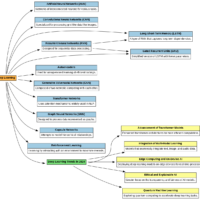Choosing the Best Optimizer for Your Deep Learning Model When training deep learning models, choosing the right optimization algorithm can significantly impact your model’s performance, convergence speed, and generalization ability. Below, we will explore some of the most popular optimization algorithms, their strengths, the reasons they were invented, and the types of problems they are best suited for. 1. Stochastic Gradient Descent (SGD) Why It Was Invented SGD is one of the earliest and most fundamental optimization algorithms used in machine learning and deep learning. It was invented to handle the challenge of minimizing cost functions efficiently, particularly when dealing with large datasets where traditional gradient descent methods would be computationally expensive. Inventor The concept of SGD is rooted in statistical learning, but its application in neural networks is often attributed to Yann LeCun and others in the 1990s. Formula The update rule for SGD is given by: where is the learning rate, is the gradient of the loss function with respect to the model parameters . Strengths and Limitations **Strengths:** SGD is particularly effective in cases where the model is simple, and the dataset is large, making it a robust choice for problems where generalization is important. The simplicity of the algorithm ensures that it does not overfit easily. **Limitations:** The main limitation of SGD is its slow convergence, especially in complex landscapes with ravines (areas where the gradient changes sharply). The formula does not account for momentum, so it can get stuck in local minima or take a long time to converge. This is particularly problematic for models with highly non-convex loss surfaces, which is common in deep learning models. The slow convergence is mathematically evident when analyzing the eigenvalues of the Hessian matrix of the loss function, where high condition numbers lead to slow progress in optimizing the parameters. Best For Simple, small-scale models or when strong generalization is needed. 2. AdaGrad Why It Was Invented AdaGrad was developed to address the issue of SGD’s sensitivity to learning rate selection. It adapts the learning rate for each parameter based on its historical gradient, allowing for more robust training in scenarios with sparse data and features. Inventor AdaGrad was introduced by John Duchi, Elad Hazan, and Yoram Singer in 2011. Formula The update rule for AdaGrad is: where is the sum of the squares of past gradients, and is a small constant added for numerical stability. Strengths and Limitations **Strengths:** AdaGrad’s strength lies in its ability to adapt the learning rate for each parameter based on the historical gradients. This makes it particularly suitable for sparse data, where some features occur infrequently and require larger updates. By dynamically adjusting the learning rate, AdaGrad ensures that these infrequent features are learned effectively. **Limitations:** The primary limitation is the decaying learning rate. As accumulates, the learning rate decreases, often to the point where the updates become too small to make further progress. This is particularly problematic for deep networks, where later layers require sustained learning rates to fine-tune the model. This is mathematically evident as grows larger, the denominator in the update rule increases, causing the overall step size to diminish. Best For Sparse datasets and problems with infrequent features. 3. RMSprop Why It Was Invented RMSprop was developed to fix AdaGrad’s diminishing learning rate issue by introducing a moving average of the squared gradients, which allows the learning rate to remain effective throughout training. Inventor RMSprop was introduced by Geoffrey Hinton in his Coursera lecture on neural networks. Formula The update rule for RMSprop is: where is the moving average of the squared gradients. Strengths and Limitations **Strengths:** RMSprop addresses AdaGrad’s limitation by maintaining a moving average of the squared gradients, ensuring that the learning rate does not diminish too quickly. This makes it particularly effective for training recurrent neural networks (RNNs), where maintaining a consistent learning rate is crucial for long-term dependencies. **Limitations:** While RMSprop effectively mitigates the learning rate decay issue, it may lead to suboptimal generalization. Since the algorithm adjusts the learning rate for each parameter individually, it can overfit certain parameters, particularly in complex models with many features. This overfitting occurs because RMSprop does not account for the correlations between parameters, which can lead to inconsistent updates that do not generalize well across different datasets. Best For Non-stationary problems or models with fluctuating gradients, particularly suitable for RNNs. 4. Adam (Adaptive Moment Estimation) Why It Was Invented Adam was designed to combine the benefits of both AdaGrad and RMSprop by using both first and second moments of the gradients to adapt the learning rate, making it effective for a wide range of deep learning tasks. Inventor Adam was introduced by Diederik P. Kingma and Jimmy Ba in 2015. Formula The update rule for Adam is: trengths and Limitations **Strengths:** Adam is well-regarded for its efficiency and adaptability. By using estimates of both the first (mean) and second (variance) moments of the gradients, it provides a robust and stable learning rate throughout training, making it particularly effective in problems with noisy or sparse gradients. The adaptability of the learning rate helps in fast convergence, especially in deep networks. **Limitations:** Despite its popularity, Adam has been shown to sometimes result in models that do not generalize as well as those trained with traditional SGD. This is because Adam tends to focus more on minimizing the loss during training rather than on ensuring good generalization. The bias-corrected moment estimates, while stabilizing, can sometimes lead the optimizer to converge to sharp minima, which might not generalize well to unseen data. Additionally, in cases where the dataset is very large or the model is extremely deep, the adaptive learning rates might not provide the same level of robustness as methods like SGD with momentum. Best For Most deep learning tasks, especially those involving noisy gradients or requiring fast convergence. 5. AdamW Why It Was Invented AdamW was developed to address the overfitting issues associated with Adam by integrating weight decay directly into the optimization process, which is better aligned with proper L2 regularization. Inventor AdamW was proposed by Ilya Loshchilov and Frank Hutter in 2019. Formula The update rule for AdamW is similar to Adam, but with weight decay applied: where is the weight decay coefficient. Strengths and Limitations **Strengths:** AdamW improves on Adam by incorporating weight decay directly into the gradient update rule, rather than as part of the gradient calculation. This subtle change helps mitigate the overfitting problem associated with Adam, leading to models that generalize better. The inclusion of weight decay ensures that the model parameters do not grow too large, which is critical for maintaining model simplicity and avoiding overfitting. **Limitations:** The primary challenge with AdamW is the need to carefully tune the weight decay parameter. If the weight decay is too large, the model might underfit, failing to capture the complexity of the data. Conversely, too small a weight decay might not sufficiently penalize large weights, leading to overfitting. This makes the optimization process more sensitive to hyperparameter selection. Best For Models requiring strong regularization, particularly in scenarios where overfitting is a significant concern. 6. Nadam Why It Was Invented Nadam is an extension of Adam that incorporates Nesterov momentum, aiming to improve convergence speed and accuracy by anticipating gradient changes. Inventor Nadam was proposed by Timothy Dozat in 2016 as an improvement over the Adam optimizer, incorporating ideas from Nesterov momentum. Formula The update rule for Nadam is: Strengths and Limitations **Strengths:** Nadam incorporates Nesterov momentum, which provides a “lookahead” mechanism, making the optimizer anticipate the path of the gradient descent more effectively. This can lead to faster and more reliable convergence, particularly in scenarios where the cost function is highly non-convex. **Limitations:** However, the added complexity of Nadam also makes it more sensitive to hyperparameter choices. In particular, the combination of momentum and adaptive learning rates can sometimes lead to overshooting the minima, especially in cases where the loss surface has sharp curves or ridges. This sensitivity can result in either slow convergence or convergence to suboptimal solutions. Best For Tasks requiring faster convergence, especially in deep recurrent networks or when computational efficiency is critical. Summary: Which Optimizer Should You Choose? General-purpose tasks: Adam and AdamW are widely used due to their adaptability and robust performance across various problems.Analytics Vidhya Sparse data: AdaGrad is effective for handling sparse data, as it adapts the learning rate for each parameter based on its historical gradients.DEV Community Non-stationary data: RMSProp is suitable for non-stationary objectives, as it adjusts the learning rate based on a moving average of recent gradients.DEV Community Emphasis on generalization: When training large neural networks where generalization is critical, starting with SGD (potentially with momentum or Nesterov Accelerated Gradient) is advisable. Freezing the embedding layer can enhance SGD’s performance, making it comparable to or even better than AdamW while using less memory.arXiv Fast convergence: NAdam, which incorporates Nesterov momentum into Adam, can be beneficial for achieving faster convergence, especially in complex models like RNNs.Wikipedia It’s important to experiment with different optimizers and adjust their hyperparameters to identify the most effective combination for your specific task. Choosing the right optimizer is often a matter of experimentation, depending on your specific dataset and model architecture. Regularly monitor your model’s performance and adjust the optimizer and its parameters as needed to ensure the best results. Comparison Table Optimizer Best For Strengths Limitations Formula SGD Simple, small-scale models Strong generalization, effective for sparse data Slow convergence, struggles with high-dimensional problems AdaGrad Sparse datasets Adapts learning rate individually, useful for sparse data Learning rate can diminish too much, stopping learning prematurely RMSprop Non-stationary problems Prevents learning rate from becoming too small, good for RNNs May not generalize as well as Adam Adam Most deep learning tasks Efficient, adaptable, good for noisy gradients May not always provide the best generalization AdamW Models requiring strong regularization Incorporates weight decay, better generalization Requires careful tuning of the weight decay parameter Nadam Tasks requiring faster convergence Combines Adam with Nesterov momentum, faster convergence May require careful tuning to avoid poor generalization…
Adam vs SGD vs AdaGrad vs RMSprop vs AdamW – Day 39




